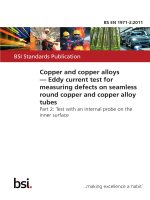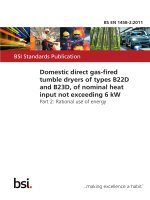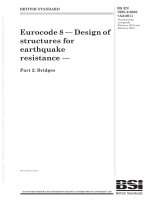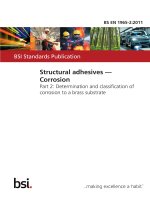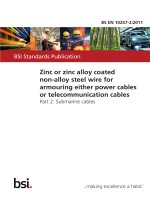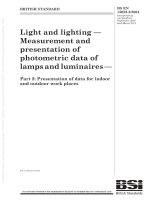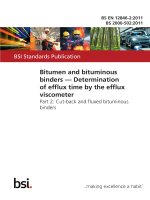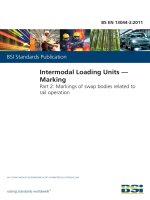Bsi bs en 62464 2 2011
Bạn đang xem bản rút gọn của tài liệu. Xem và tải ngay bản đầy đủ của tài liệu tại đây (1.07 MB, 18 trang )
BS EN 62464-2:2011
BSI Standards Publication
Magnetic resonance
equipment for medical
imaging
Part 2: Classification criteria for
pulse sequences
BRITISH STANDARD
BS EN 62464-2:2011
National foreword
This British Standard is the UK implementation of EN 62464-2:2011. It is
identical to IEC 62464-2:2010.
The UK participation in its preparation was entrusted by Technical Committee
CH/62, Electrical Equipment in Medical Practice, to Subcommittee CH/62/2,
Diagnostic imaging equipment.
A list of organizations represented on this committee can be obtained on
request to its secretary.
This publication does not purport to include all the necessary provisions of a
contract. Users are responsible for its correct application.
© BSI 2011
ISBN 978 0 580 69735 7
ICS 11.040.55
Compliance with a British Standard cannot confer immunity from
legal obligations.
This British Standard was published under the authority of the Standards
Policy and Strategy Committee on 31 March 2011.
Amendments issued since publication
Amd. No.
Date
Text affected
BS EN 62464-2:2011
EUROPEAN STANDARD
EN 62464-2
NORME EUROPÉENNE
February 2011
EUROPÄISCHE NORM
ICS 11.040.55
English version
Magnetic resonance equipment for medical imaging Part 2: Classification criteria for pulse sequences
(IEC 62464-2:2010)
Appareils à résonance magnétique utilisés
pour l'imagerie médicale Partie 2: Critères de classification pour les
séquences d'impulsions
(CEI 62464-2:2010)
Magnetresonanzgeräte für die
medizinische Bildgebung Teil 2: Klassifizierungskriterien für
Pulssequenzen
(IEC 62464-2:2010)
This European Standard was approved by CENELEC on 2011-02-01. CENELEC members are bound to comply
with the CEN/CENELEC Internal Regulations which stipulate the conditions for giving this European Standard
the status of a national standard without any alteration.
Up-to-date lists and bibliographical references concerning such national standards may be obtained on
application to the Central Secretariat or to any CENELEC member.
This European Standard exists in three official versions (English, French, German). A version in any other
language made by translation under the responsibility of a CENELEC member into its own language and notified
to the Central Secretariat has the same status as the official versions.
CENELEC members are the national electrotechnical committees of Austria, Belgium, Bulgaria, Croatia, Cyprus,
the Czech Republic, Denmark, Estonia, Finland, France, Germany, Greece, Hungary, Iceland, Ireland, Italy,
Latvia, Lithuania, Luxembourg, Malta, the Netherlands, Norway, Poland, Portugal, Romania, Slovakia, Slovenia,
Spain, Sweden, Switzerland and the United Kingdom.
CENELEC
European Committee for Electrotechnical Standardization
Comité Européen de Normalisation Electrotechnique
Europäisches Komitee für Elektrotechnische Normung
Management Centre: Avenue Marnix 17, B - 1000 Brussels
© 2011 CENELEC -
All rights of exploitation in any form and by any means reserved worldwide for CENELEC members.
Ref. No. EN 62464-2:2011 E
BS EN 62464-2:2011
EN 62464-2:2011
-2-
Foreword
The text of document 62B/807/FDIS, future edition 1 of IEC 62464-2, prepared by SC 62B, Diagnostic
imaging equipment, of IEC TC 62, Electrical equipment in medical practice, was submitted to the
IEC-CENELEC parallel vote and was approved by CENELEC as EN 62464-2 on 2011-02-01.
Attention is drawn to the possibility that some of the elements of this document may be the subject of
patent rights. CEN and CENELEC shall not be held responsible for identifying any or all such patent
rights.
The following dates were fixed:
– latest date by which the EN has to be implemented
at national level by publication of an identical
national standard or by endorsement
(dop)
2011-11-01
– latest date by which the national standards conflicting
with the EN have to be withdrawn
(dow)
2014-02-01
In this standard, the following print types are used:
– Requirements and definitions: roman type.
– Test specifications: italic type.
– Informative material appearing outside of tables, such as notes, examples and references: in smaller type. Normative text of
tables is also in a smaller type.
– TERMS DEFINED IN CLAUSE 3 OF THE GENERAL STANDARD, IN THIS PARTICULAR STANDARD OR AS NOTED:
SMALL CAPITALS.
The verbal forms used in this standard conform to usage described in Annex H of the ISO/IEC Directives,
Part 2. For the purposes of this standard, the auxiliary verb:
– “shall” means that compliance with a requirement or a test is mandatory for compliance with this
standard;
– “should” means that compliance with a requirement or a test is recommended but is not mandatory for
compliance with this standard;
– “may” is used to describe a permissible way to achieve compliance with a requirement or test.
Annex ZA has been added by CENELEC.
__________
Endorsement notice
The text of the International Standard IEC 62464-2:2010 was approved by CENELEC as a European
Standard without any modification.
__________
BS EN 62464-2:2011
EN 62464-2:2011
-3-
Annex ZA
(normative)
Normative references to international publications
with their corresponding European publications
The following referenced documents are indispensable for the application of this document. For dated
references, only the edition cited applies. For undated references, the latest edition of the referenced
document (including any amendments) applies.
NOTE When an international publication has been modified by common modifications, indicated by (mod), the relevant EN/HD
applies.
Publication
Year
Title
EN/HD
Year
IEC 60601-2-33
2010
Medical electrical equipment Part 2-33: Particular requirements for the
basic safety and essential performance of
magnetic resonance equipment for medical
diagnosis
EN 60601-2-33
+ corr. October
2010
2010
IEC/TR 60788
2004
Medical electrical equipment - Glossary of
defined terms
-
-
BS EN 62464-2:2011
–2–
62464-2 Ó IEC:2010
CONTENTS
INTRODUCTION ............................................................................................................ 5
1
Scope ...................................................................................................................... 6
2
Normative references ................................................................................................ 6
3
Terms and definitions ................................................................................................ 6
4
P ULSE
4.1
4.2
4.3
4.4
4.5
Annex A
SEQUENCE
classification ................................................................................... 7
General ........................................................................................................... 7
P ULSE SEQUENCE type ....................................................................................... 7
4.2.1 General ................................................................................................ 7
4.2.2 Notation ............................................................................................... 8
Magnetisation modification ................................................................................ 8
4.3.1 General ................................................................................................ 8
4.3.2 Notation ............................................................................................... 8
Dimensionality ............................................................................................... 10
4.4.1 General .............................................................................................. 10
4.4.2 Notation ............................................................................................. 10
Echo number ................................................................................................. 10
4.5.1 General .............................................................................................. 10
4.5.2 Notation ............................................................................................. 10
(informative) Examples of use of the PULSE SEQUENCE classification ..................... 11
Bibliography ................................................................................................................. 12
Index of defined terms used in this standard ................................................................... 13
Table 1 – Magnetisation modification techniques ............................................................... 9
Table A.1 – M ANUFACTURER -specific classification examples ............................................. 11
BS EN 62464-2:2011
62464-2 Ó IEC:2010
–5–
INTRODUCTION
Presently the MANUFACTURERS of MR EQUIPMENT use names for PULSE SEQUENCES which are
adopted from the literature (e.g. SPIN- ECHO ) or are defined by the MANUFACTURER (e.g. FISP:
fast imaging with steady state precession). In the absence of a classification standard for
PULSE SEQUENCES , the MANUFACTURER -specific terminology complicates comparison of PULSE
SEQUENCES .
The DICOM standard allows the inclusion of PULSE SEQUENCE information with digital
( MR) images. This information helps with the interpretation of images.
However, the DICOM standard allows MANUFACTURER -specific terminology.
MAGNETIC RESONANCE
This International Standard specifies a concise
scheme for MR imaging PULSE SEQUENCES.
MANUFACTURER -independent
classification
In terms of MR imaging, the PULSE SEQUENCE is a chronology of RF-pulses, switching of
gradient fields and data acquisition with the intention to create one or more images. As the
exact chronology determines the image contrast, image artefacts and other properties of the
image, it is necessary to define a consistent and accurate PULSE SEQUENCE classification.
The proposed PULSE SEQUENCE classification notation could be implemented as a new DICOM
tag in addition to the existing MANUFACTURER -specific PULSE SEQUENCE name. This would
facilitate end users’ access to this information. Implementation as a new tag would ensure
backward compatibility.
BS EN 62464-2:2011
–6–
62464-2 Ó IEC:2010
MAGNETIC RESONANCE EQUIPMENT FOR MEDICAL IMAGING –
Part 2 – Classification criteria for pulse sequences
1
Scope
This International Standard specifies the description of
imaging.
PULSE SEQUENCES
of
MAGNETIC
RESONANCE
NOTE
The classification in this standard is suitable for:
–
tender texts;
–
image annotation;
–
protoc ol definition;
–
technical publications.
This International Standard does not apply to MAGNETIC RESONANCE spectroscopy. The
classification does not focus on image contrast (T1, T2, proton density), as this is defined by
PULSE SEQUENCE parameters (e.g. repetition time, echo time) and is not a property of the
PULSE SEQUENCE alone. The PULSE SEQUENCE classification does not specify the K - SPACE
acquisition scheme, reconstruction algorithm or post-processing.
2
Normative references
The following referenced documents are indispensable for the application of this document.
For dated references, only the edition cited applies. For undated references, the latest edition
of the referenced document (including any amendments) applies.
IEC 60601-2-33:2010, Medical electrical equipment – Part 2-33: Particular requirements for
the basic safety and essential performance of magnetic resonance equipment for medical
diagnosis
IEC 60788:2004, Medical electrical equipment – Glossary of defined terms
3
Terms and definitions
For the purposes of this document, the terms and definitions given in IEC 60601-2-33:2010,
IEC 60788:2004 and the following apply.
3.1
pulse sequence
chronology of radiofrequency-pulses, switching of magnetic field gradients, and data
acquisition for the generation of one or more MAGNETIC RESONANCE images
NOTE
The terms “imaging sequence” or “sequenc e” are sometimes used as synonyms for PULSE SEQUENCE .
3.2
transverse magnetisation
magnetisation component perpendicular to the direction of the static magnetic field
3.3
longitudinal magnetisation
magnetisation component parallel to the direction of the static magnetic field
BS EN 62464-2:2011
62464-2 Ó IEC:2010
–7–
3.4
k-space
mathematical space in which the Fourier transform of the image data is represented
NOTE
This is partially or totally filled with the s ampled meas urement data.
3.5
spin-echo
SE
refocused TRANSVERSE MAGNETISATION arising at time T after an excitation RF pulse and an
additional RF-pulse at time T/2
NOTE The excitation pulse is typically a 90° RF puls e, and the additional refocusing puls e is typic ally a 180° RF
pulse. SE's can be refocused using a s equence of additional RF pulses.
3.6
gradient-echo
GR
refocused TRANSVERSE
gradients
4
MAGNETISATION
after a RF pulse using re-phasing magnetic field
P ULSE SEQUENCE classification
4.1
General
In an imaging PULSE SEQUENCE the LONGITUDINAL MAGNETISATION is partially or totally
converted into TRANSVERSE MAGNETISATION via a radio-frequency (RF) excitation pulse. The
TRANSVERSE MAGNETISATION is precessing with the Larmor frequency. The precessing
TRANSVERSE MAGNETISATION induces the MR signal. For spatial encoding the precessing
TRANSVERSE MAGNETISATION is phase-encoded with the help of gradients prior to the data
acquisition, and frequency encoding is utilised during the data acquisition. The acquired
signal is then stored in a so-called K- SPACE line of the raw data matrix.
The K- SPACE can be two- (2D) or three-(3D)-dimensional. There are several algorithms that
allow reconstructing images from incomplete K -SPACE data sets (half or partial Fourier,
parallel imaging techniques) – for the PULSE SEQUENCE classification these techniques are not
considered.
P ULSE
SEQUENCES
are categorised according to the following classifiers:
a) magnetisation modification (optional): modification(s) of the
or TRANSVERSE MAGNETISATION ;
b)
LONGITUDINAL MAGNETISATION
PULSE SEQUENCE type: SPIN - ECHO or GRADIENT - ECHO with the number repetitions (or shots)
and the number of K- SPACE lines per RF excitation;
c) dimensionality of data acquisition: 2D or 3D;
d) echo number (optional): number of different echoes that are used to calculate separate
images.
These classifiers are used in the following notation (without spaces):
<Magnetisation modification> – <Dimensionality of data acquisition> – type> – <Echo number>
4.2
4.2.1
P ULSE
SEQUENCE
SEQUENCE
type
General
P ULSE SEQUENCES create MR images whose signal behaviour is primarily determined by either
a SPIN - ECHO ( SE) or a GRADIENT - ECHO ( GR ). The PULSE SEQUENCE type is defined at the centre
BS EN 62464-2:2011
–8–
62464-2 Ó IEC:2010
of the 2D or 3D K - SPACE: If the K - SPACE centre is acquired with a SPIN -ECHO , then the PULSE
SEQUENCE is classified as a SPIN - ECHO PULSE SEQUENCE in this International Standard. If the
centre of K - SPACE is not acquired with a SPIN- ECHO , then the PULSE SEQUENCE is classified as a
GRADIENT - ECHO PULSE SEQUENCE in this International Standard.
A more precise classification the PULSE SEQUENCE type is achieved by providing information
about the other K - SPACE lines. Therefore, the number of SPIN - ECHOES and GRADIENT - ECHOES
per RF excitation are given.
Some image characteristics are sensitive to whether K - SPACE is totally acquired after a single
RF excitation (single shot) or whether multiple RF excitations are required (multi-shot), so the
number of RF excitations (shots) is also given.
4.2.2
For a
Notation
SPIN - ECHO PULSE SEQUENCE
the following notation is used:
< PULSE SEQUENCE type> : (SE_<Index1> GR_<Index2>)_<Index3>
For a
GRADIENT - ECHO PULSE SEQUENCE
the following notation is used:
< PULSE SEQUENCE type> : (GR_<Index1> SE_<Index2>)_<Index3>
Here, <Index1> and <Index2> denote the number of SPIN -ECHOES and GRADIENT - ECHOES,
respectively. The values of <Index1> and <Index2> can be either integer numbers or formulas
of the variables N and M using the signs “+”, “-“, “/”, and “x”. Here, N describes the total
number of K - SPACE lines, and M is the number of K - SPACE lines per excitation. The part
“GR_<Index2>“ or “SE_<Index2>“ is omitted, if <Index2> is zero.
<Index3> denotes the number of required RF excitations and is given either as an integer
number or a formula of the variables N and M using the signs “+”, “-“, “/”, and “x”.
NOTE The sum of <Index1> and <Index2> is typically known as the echo train length, and <Index3> is often
written as the number of shots.
4.3
4.3.1
Magnetisation modification
General
Optionally, the imaging characteristics of a PULSE SEQUENCE can be changed by adding
gradients and RF pulses or by replacing parts of the PULSE SEQUENCE. These added pulses
and gradients are used to prepare the magnetisation.
Different magnetisation modifications can be combined. The magnetisation modification is
either acting primarily on the LONGITUDINAL MAGNETISATION or the TRANSVERSE MAGNETISATION ,
or is done during RF excitation.
For classification of the magnetisation modification, all parts of the PULSE SEQUENCES that
have an additional influence on the image characteristics and that are not included in the
classification of the PULSE SEQUENCE type are listed.
4.3.2
Notation
The magnetisation modification is written as a series of symbols as given in Table 1:
<Magnetisation modification> : <Symbol1> – <Symbol2> – ... – <SymbolN>
If no magnetisation modification is used, this classifier is omitted.
BS EN 62464-2:2011
62464-2 Ó IEC:2010
–9–
Table 1 – Magnetisation modification techniques
Symbol
Name
Physical principle
IR
Inversion rec overy
Inversion of the LONGITUDINAL MAGNETISATION
SR
Saturation rec overy
Saturation of the LONGITUDINAL MAGNETISATION
T2P
T2 preparation
Storage of a T2 contrast in the LONGITUDINAL MAGNETISATION
using e.g. the pulses (90°)-(180°)-(-90°)
T2SP
T2* preparation
Storage of a T2* contrast in the LONGITUDINAL MAGNETISATION
using e.g. the pulses (90°)-TE-(-90°)
SSAT
Spectral (chemical) saturation
Spectrally selective saturation of spins (e.g. fat, silicone,
water)
SIR
Spectral (chemical) inversion
Spectrally selective inversion of spins (e.g. fat, silicone,
water)
MTC
Magnetis ation transfer contrast
Indirect saturation of the water signal using magnetisation
transfer of spins bound to macromolecules
RSAT
(Regional) pre-saturation, tagging
Spatially selective s aturation
RLAB
(Regional) labelling, spin labelling
Spatially selective excitation or inversion for tagging of
moving spins
DE
Driven equilibrium
RF pulse at the end of the echo train for restoring the
LONGITUDINAL MAGNETISATION
NS
Non-spatially s elective excitation
RF pulse without slice selection gradient to excite all
magnetis ation in the volume of the transmitting RF c oil
NRRF
Profiled (non-rectangular) RF puls e
RF excitation pulse with a dedicated, non-r ectangular slice
profile (e.g. to avoid saturation effects in TOF MR
angiographies or for simultaneous excitation of two slices)
2DRF
2D selective RF pulse
RF pulse with a spatial selectivity in 2 dimensions
SSRF
Spatial-spectral RF pulse
Simultaneous spatially and spectrally s elective excitation
DIFF
Diffusion weighting
Signal attenuation by additional gradients that induc e a
signal dephasing for diffusing spins
FLOW Cn
Flow compensation a
Compens ation of the n gradient moment to suppress flow
related signal changes, where n is a positive integer
FLOW Sn
Flow sensitisation
Amplification of the n gradient moment to enhance flow
related signal changes, where n is a positive integer
T1R
Spin lock
T1r contrast by additional RF pulses
SPOIL
T RANSVERSE MAGNETISATION spoiling
Spoiling by gradient and/or radio frequenc y
AREF
Refocusing of all gradients
Refocusing of all gradients within one TR interval (balanc ed
steady state free precession)
PREF
Partial refocusing of the gradients
Refocusing of some gradients within one TR interval
NREF
Refocusing of the gradients in the
next TR interval
Refocusing of the gradients so that an echo is acquired in
the next TR interval
OFFSET
Offset echo
Time offset between the SPIN ECHO and acquisition of the
centre of K - SPACE
a
th
th
If the classifier FLOW Cn is not explicitly given, the PULSE SEQUENCE does not utilise flow compensation.
BS EN 62464-2:2011
– 10 –
4.4
4.4.1
62464-2 Ó IEC:2010
Dimensionality
General
With three-dimensional data acquisitions the spatial encoding of the signal from a volume is
performed in all three dimensions, and data are sorted into a 3D K- SPACE. In two-dimensional
data acquisitions encoding is performed only in the two in-plane dimensions of a selected
slice, and a 2D K- SPACE is filled.
4.4.2
Notation
The dimensionality for a two-dimensional data acquisition is given by
<Dimensionality> : 2D
For a three-dimensional data acquisition the following notation is used:
<Dimensionality> : 3D
4.5
4.5.1
Echo number
General
Following an RF excitation, data can be acquired at different echo times, which leads to MR
images with different contrasts. The number of reconstructed images with different contrasts
is classified by the echo number.
4.5.2
Notation
The following notation is used for the echo number:
<Echo number> : E_ <Index>
<Index> is an integer number. If <Index> has a value of 1, the classifier is omitted.
BS EN 62464-2:2011
62464-2 Ó IEC:2010
– 11 –
Annex A
(informative)
Examples of use of the
PULSE SEQUENCE
classification
Table A.1 shows examples of the application of this International Standard to
specific PULSE SEQUENCE names.
MANUFACTURER -
Table A.1 – M ANUFACTURER -specific classification examples
GE
Hitachi
Philips
Siemens
Toshiba
This International
Standard
EPI
GE EPI
Single shot
FFE-EPI
FID-EPI
EPI
2D–(GR_N)_1
EPI
SE EPI
Single shot
SE-EPI
SE-EPI
EPI
2D–(SE_1-GR_N-1)_1
FGRE-ET
Multi shot EPI
Multi shot EPI
Segmented
EPI
Multi-shot EPI
2D–(GR_M)_N/M
SPIN - ECHO
SPIN - ECHO
SPIN - ECHO
SPIN - ECHO
SPIN - ECHO
2D–(SE_1)_N
SS-FSE
Single shot
FSE
Single shot
TSE
HASTE/RARE
FASE
2D–(SE_N)_1
fast SPIN - ECHO
fast SPIN - ECHO
FSE
2D–(SE_M)_N/M
dual echo fast
turbo S PIN -
turbo S PIN -
ECHO
ECHO
<tbd>
<tbd>
2D–(SE_M)_N/M–E_2
SPIN ECHO
FLAIR/STIR
FLAIR/STIR
FLAIR/STIR
FLAIR/STIR
FLAIR/STIR
IR–2D–(SE_M)_N/M
GRASE
-
GRASE
TGSE
Hybrid EPI
2D–(SE_1-GR_M1)_N/M
Spoiled
GRASS
RSSG
T1-FFE
FLASH
FE
SPOIL–2D–(GR_1)_N
GRASS
SARGE
FFE
FISP
FE
PREF–2D–(GR_1)_N
FIESTA
BASG
Balanced FFE
True FISP
True SSFP
AREF–2D–(GR_1)_N
SSFP
TRSG
T2-FFE
PSIF
SSFP
NREF–2D–(GR_1)_N
BS EN 62464-2:2011
– 12 –
62464-2 Ó IEC:2010
Bibliography
DICOM 2008 standard: Digital Imaging and Communications in Medicine (DICOM) [viewed
2010-07-15]. Available from />RadLex Term Browser [viewed 2010-07-15]. Available from />
BS EN 62464-2:2011
62464-2 Ó IEC:2010
– 13 –
Index of defined terms used in this standard
NOTE
The defined terms used in this International Standard may be looked up at />
GRADIENT - ECHO ( GR ) .....................................................................................................
3.6
K - SPACE ......................................................................................................................
3.4
LONGITUDINAL MAGNETISATION
........................................................................................ 3.3
MAGNETIC RESONANCE ( MR ) .................................................. IEC
60601-2-33:2010, 201.3.217
MANUFACTURER ...............................................................................IEC
MR EQUIPMENT .................................................................... IEC
60601-1:2005, 3.55
60601-2-33:2010, 201.3.218
PULSE SEQUENCE ..........................................................................................................
SPIN - ECHO ( SE )
3.1
............................................................................................................ 3.5
TRANSVERSE MAGNETISATION ..........................................................................................
___________
3.2
This page deliberately left blank
This page deliberately left blank
NO COPYING WITHOUT BSI PERMISSION EXCEPT AS PERMITTED BY COPYRIGHT LAW
British Standards Institution (BSI)
BSI is the national body responsible for preparing British Standards and other
standards-related publications, information and services.
BSI is incorporated by Royal Charter. British Standards and other standardization
products are published by BSI Standards Limited.
About us
Revisions
We bring together business, industry, government, consumers, innovators
and others to shape their combined experience and expertise into standards
-based solutions.
Our British Standards and other publications are updated by amendment or revision.
The knowledge embodied in our standards has been carefully assembled in
a dependable format and refined through our open consultation process.
Organizations of all sizes and across all sectors choose standards to help
them achieve their goals.
Information on standards
We can provide you with the knowledge that your organization needs
to succeed. Find out more about British Standards by visiting our website at
bsigroup.com/standards or contacting our Customer Services team or
Knowledge Centre.
Buying standards
You can buy and download PDF versions of BSI publications, including British
and adopted European and international standards, through our website at
bsigroup.com/shop, where hard copies can also be purchased.
If you need international and foreign standards from other Standards Development
Organizations, hard copies can be ordered from our Customer Services team.
Subscriptions
Our range of subscription services are designed to make using standards
easier for you. For further information on our subscription products go to
bsigroup.com/subscriptions.
With British Standards Online (BSOL) you’ll have instant access to over 55,000
British and adopted European and international standards from your desktop.
It’s available 24/7 and is refreshed daily so you’ll always be up to date.
You can keep in touch with standards developments and receive substantial
discounts on the purchase price of standards, both in single copy and subscription
format, by becoming a BSI Subscribing Member.
PLUS is an updating service exclusive to BSI Subscribing Members. You will
automatically receive the latest hard copy of your standards when they’re
revised or replaced.
To find out more about becoming a BSI Subscribing Member and the benefits
of membership, please visit bsigroup.com/shop.
With a Multi-User Network Licence (MUNL) you are able to host standards
publications on your intranet. Licences can cover as few or as many users as you
wish. With updates supplied as soon as they’re available, you can be sure your
documentation is current. For further information, email
BSI Group Headquarters
389 Chiswick High Road London W4 4AL UK
We continually improve the quality of our products and services to benefit your
business. If you find an inaccuracy or ambiguity within a British Standard or other
BSI publication please inform the Knowledge Centre.
Copyright
All the data, software and documentation set out in all British Standards and
other BSI publications are the property of and copyrighted by BSI, or some person
or entity that owns copyright in the information used (such as the international
standardization bodies) and has formally licensed such information to BSI for
commercial publication and use. Except as permitted under the Copyright, Designs
and Patents Act 1988 no extract may be reproduced, stored in a retrieval system
or transmitted in any form or by any means – electronic, photocopying, recording
or otherwise – without prior written permission from BSI. Details and advice can
be obtained from the Copyright & Licensing Department.
Useful Contacts:
Customer Services
Tel: +44 845 086 9001
Email (orders):
Email (enquiries):
Subscriptions
Tel: +44 845 086 9001
Email:
Knowledge Centre
Tel: +44 20 8996 7004
Email:
Copyright & Licensing
Tel: +44 20 8996 7070
Email:
